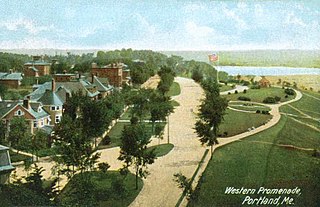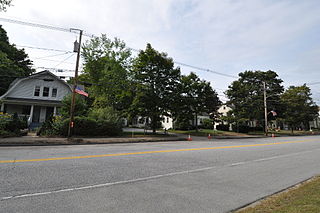
Falmouth is a town in Cumberland County, Maine, United States. The population was 12,444 at the 2020 census. It is part of the Portland–South Portland–Biddeford, Maine metropolitan statistical area.

Percival Proctor Baxter was an American politician and philanthropist from Maine. The son of canning magnate and Portland, Maine, mayor James Phinney Baxter, he served as the 53rd Governor of the U.S. state of Maine from 1921 to 1925. A noted philanthropist, he donated several pieces of land to the public domain including Baxter Woods (Portland), Mackworth Island State Park (Falmouth), and Baxter State Park.

Casco Bay is an inlet of the Gulf of Maine on the coast of Maine in the United States. The National Oceanic and Atmospheric Administration's chart for Casco Bay marks the dividing line between the bay and the Gulf of Maine as running from Bald Head on Cape Small in Phippsburg west-southwest to Dyer Point in Cape Elizabeth. The city of Portland and the Port of Portland are on Casco Bay's western edge.

Cushing Island, or Cushing's Island, is a privately owned island in Casco Bay in the U.S. state of Maine. Part of the city of Portland, roughly 45 families live there seasonally.

Baxter Boulevard is a boulevard and parkway in Portland, Maine. The road, around 1.91 miles (3.07 km) long, served as the means to head north from downtown Portland before Tukey's Bridge, now on Interstate 295 (I-295), was built. The road was part of U.S. Route 1 (US 1) until May 2007. The parkway wraps around the west side of Back Cove estuary basin.

Portland High School is a public high school established in 1821 in Portland, Maine, United States, which educates grades 9–12. The school is part of the Portland Public Schools district, and is one of three high schools in that district, along with Deering High School and Casco Bay High School. It is located at 284 Cumberland Avenue in downtown Portland. Along with its sister school, Deering High School, a family can choose which of the two to send their students to.

Mackworth Island is an approximately 100-acre (40 ha) island in Casco Bay, Maine, United States. Politically, it is part of the town of Falmouth, which is adjacent to Portland. In 1631, Sir Ferdinando Gorges, who first attempted to colonize Maine, gifted the island to Arthur Mackworth, his deputy in Casco Bay, and the island has retained his name. A causeway, which carries the traffic of Andrews Avenue, connects the island to Mackworth Point on the mainland. Visitors to the island must pass a state park entrance tollhouse and pay an entrance fee; cars can enter the island, but parking is limited. There is a footpath around the perimeter of the island with views of Falmouth, Portland, and other islands surrounding the bay. The island is heavily wooded and one portion of those woods is dedicated to "Fairy Houses" which are constructed by visitors using natural materials found on the island. Although most areas of the island are State Park lands, there is a school area that is not open to the public. The island is also home to the Governor Baxter Dog Memorial, a pet cemetery where fourteen of the former governor's Irish Setters and one of his horses were laid to rest, accompanied by two bronze markers and a gravestone, all enclosed by a circular stone wall.
James Phinney Baxter III was an American historian, educator, and academic, who won the 1947 Pulitzer Prize for History for his book Scientists Against Time (1946). He was also the author of The Introduction of the Ironclad Warship (1933).

Eagle Island is an island in Maine's Casco Bay and the site of the summer home of the North Pole explorer Admiral Robert Peary (1856–1920). The island and home are preserved as the Eagle Island State Historic Site.

James Phinney Baxter was an American politician, businessperson, historian, civic leader, and benefactor of Portland, Maine. He was elected as mayor of Portland for six single-year terms between 1893 and 1905.

Evergreen Cemetery is a garden-style cemetery on Stevens Avenue in the Deering neighborhood of Portland, Maine. With 239 acres (97 ha) of land, it is the largest cemetery in the state. Established in 1855, in what was then Westbrook, the cemetery is home to one of the state's most prominent collections of funerary art. The 140-acre (57 ha) historical portion of the cemetery was listed on the National Register of Historic Places in 1992.

Captain Christopher Levett was an English writer, explorer and naval captain, born at York, England. He explored the coast of New England and secured a grant from the king to settle present-day Portland, Maine, the first European to do so. Levett left behind a group of settlers at his Maine plantation in Casco Bay, but they were never heard from again. Their fate is unknown. As a member of the Plymouth Council for New England, Levett was named the Governor of Plymouth in 1623 and a close adviser to Capt. Robert Gorges in his attempt to found an early English colony at Weymouth, Massachusetts, which also failed. Levett was also named an early governor of Virginia in 1628, according to Parliamentary records at Whitehall.

The Maine Historical Society is the official historical society of the U.S. state of Maine. It is located at 489 Congress Street in downtown Portland. The Society currently operates the Wadsworth-Longfellow House, a National Historic Landmark, Longfellow Garden, the Maine Historical Society Museum and Store, the Brown Research Library, as well as the Maine Memory Network, an online database of documents and images that includes resources from many of state's local historical societies.
Portland, Maine, is home to many neighborhoods.

The Western Promenade is a historic promenade, an 18.1-acre (7.3 ha) public park and recreation area in the West End neighborhood of Portland, Maine. Developed between 1836 and the early 20th century, it is one Portland's oldest preserved spaces, with landscaping by the Olmsted Brothers, who included it in their master plan for the city's parks. The promenade was listed on the National Register of Historic Places in 1989.

The Baxter House is an historic house museum at 67 South Street in Gorham, Maine, United States. Built in 1797, it was the birthplace of James Phinney Baxter, mayor of Portland. He was the father of two-term Governor of Maine Percival Baxter. The house was donated to the town by James Phinney Baxter in 1907, and opened as a museum in 1908. It is open on Tuesdays and Thursdays from June to August. It was listed on the National Register of Historic Places in 1979.

John Paul Jones Memorial Park is a municipal park in the town of Kittery, Maine. The trapezoidal park, flanked by the lanes of United States Route 1 approaching the Memorial Bridge across the Piscataqua River, was established in 1926 and named for American Revolutionary War naval hero John Paul Jones. Its centerpiece is a memorial commemorating the soldiers and sailors of the state of Maine, designed by Bashka Paeff. The park was listed on the National Register of Historic Places in 1998.

The South Street Historic District encompasses an early residential area of Gorham, Maine. Located just south of Gorham's small commercial center, South Street is lined with an architecturally cohesive collection of about 20 late-18th and early-19th century houses, primarily interrupted only by the presence of the modest Colonial Revival Baxter Memorial Library. The district was listed on the National Register of Historic Places in 1988.
The Governor Baxter School for the Deaf (GBSD), formerly known as the Maine School for the Deaf is a public co-educational school that serves the deaf and hard-of-hearing in the State of Maine. It is located on Mackworth Island, an approximately 100-acre (40 ha) island in Falmouth, Maine, USA, adjacent to its border with Portland, Maine. Students who live far away may stay with host families, who provide residential services. Its program is the Maine Educational Center for the Deaf and Hard of Hearing (MECDHH).

The Butler School is a historic schoolhouse turned apartment building in Portland, Maine, United States. Built from 1878 to 1879 at the cost of $8,000, the building served as an elementary school for West End students until 1973. It is located on Pine Street in Andrews Square. It is named for Moses M. Butler, who was mayor from 1877 to 1879. It was designed by local architect Francis H. Fassett in the High Victorian Gothic style; Fassett lived in the neighborhood and also designed many other nearby buildings on the Western Promenade. It was built to replace nearby Brackett Street School and itself was replaced by Howard C. Reiche Community School, which was built a block away on Brackett Street. It did not have a playground until 1945.



















